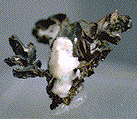

- Chemistry: Al, Elemental Aluminum
- Class: Elements
- Subclass: Native Metals
- Uses: Anywhere a light weight metal is needed, also explosives and medications.
Specimens
Native aluminum rarely occurs naturally in its elemental form, even though only oxygen and silicon are more abundant in the earth's crust. It has been found in volcanic muds and as tiny grains in highly unusual environments along with other elemental metals.
Aluminum is known as aluminium outside of the United States.
Production of metallic aluminum from ores is done via electrolysis; a large electric current generates aluminum at the cathode, and oxygen is released at the anode.
While aluminum is soft and weak in its pure form, when alloyed with other metals such as copper, magnesium or manganese its mechanical properties can improve greatly. Aluminum only has 60% of the electrical conductivity of copper, but its light weight and relatively low cost make it the preferred metal for many electrical transmission applications. Aluminum is relatively strong (per unit of weight), as strong as steel although only about half as strong as titanium, which when combined with its low cost makes it a popular metal for building things from beer cans to lawn chairs to boats to airplanes. It is easy to manufacture since it is the second most malleable metal and the sixth most ductile - the only difficulty is in welding it.
Actually, aluminum is extremely reactive, and any bare surface instantly grows a microscopic oxide layer (corundum) that is air tight and prevents further oxidation. In extreme heat, aluminum can begin to burn (similarly to magnesium), and can even burn under water by stealing the oxygen from water. The mixture called thermite is powdered aluminum and iron oxide (usually magnetite). When ignited, the aluminum steals the oxygen from the rust, generating a great deal of heat and leaving molten iron. Also, powdered aluminum is the primary fuel (to be oxidized) in slow explosives such as fireworks, and in solid fuel rockets including the Space Shuttle boosters.
It is aluminum's highly reactive nature that prevents the natural occurrence of elemental aluminum in natural specimens. Over a number of years (slow by human time scales, but a blink of an eye in geologic time) any metallic aluminum exposed to weathering processes, water, and oxygen, will decompose. The only native aluminum mineral grains have been found in some highly reduced (low oxygen) recently produced volcanic muds and rocks, plus meteorites. Rarely, native aluminum specimens can be found as grains in polished slabs, but most elemental aluminum specimens sold in rock shops are lab grown, likely by boiling aluminum in a contained vessel and allowing the vapors to condense along the walls and roof of the container. While these specimens can indeed be aesthetically pleasing, they are not natural or native aluminum crystals.
PHYSICAL CHARACTERISTICS:
- Color is silvery-white.
- Luster is metallic.
- Transparency: Crystals are opaque.
- Crystal System is isometric.
- Crystal Habits are limited to microscopic inclusions and as nodules in volcanic muds.
- Cleavage is absent.
- Hardness 1.5 (very soft)
- Specific Gravity is 2.72 (very light for metals).
- Streak is white.
- Associated Minerals include gold, copper, and zinc.
- Notable Occurrences are limited to Russia, Zaire, and Baku, Azerbaidzhan.
- Best Field Indicators: Rarity, color, softness, luster and locality.







